The ultimate installation of Home Assistant: Docker, HACS Plugin and HTTPS

Why not install HomeAssistant? directly on the computer.
Apparently installing HomeAssistant directly on the operating system (whether on a Raspberry or a regular PC) may seem like the best way to take advantage of one of the world’s most popular home automation and automation software. However, this solution also brings with it several limitations, which manifest themselves in the most annoying ways possible:
- Inability to choose the operating system of the host on which HomeAssistant will be installed. Indeed, there are many situations for which we cannot reinstall the operating system from 0, just think of a NAS or the possibility of employing a computer with incompatibilities or with other services already configured.
- Do you need to use the computer for other services and literally want to go crazy to get all the dependencies between Home Assistant and your software to work?
- If I need to migrate my Home Assistant instance, I have to reinstall everything from scratch on the new pc.
- Since it is a boxed, ready-made system, the configuration and log files will be on default paths within the machine. To go and save them elsewhere or provide mechanisms for manually backing up files we would have to modify the system and risk having to reconfigure everything every time we upgrade.
- Did you do a HomeAssistant or security update and the computer no longer turns on? Big problem when the only feasible solution is to reinstall everything from scratch.
To put it simply, you risk wasting a lot of time, having an unreliable and inflexible system.
The alternative to containers: Docker
The Docker solution involves installing our instance of HomeAssistant inside a Docker container, freeing us almost completely from the base operating system. It can be said that in this mode we avoid all the disadvantages we identified above in the simple installation.
With the right approach, moreover, we can take advantage of a whole series of extra features with ease, such as HTTPS encryption, the use of a url without having to remember port numbers, the ability to change versions effortlessly and without “damaging” the environment.
But is it more complicated to install HomeAssistant in this mode? Is it difficult to get an instance with HTTPS enabled? And can I still use my HACS plugins?
it’s all in the guide! keep reading and you will find it already done
The ultimate solution to install Home Assistant
Prerequisites.
- A local server, such as an old pc or a power-saving one that is always on. Anything from rack mount servers to Intel NUCs (I personally do well with the Gigabyte Brix) and maybe why not, a Raspberry.
NoteThe guide describes the steps in case of using intel x64 architecture on Linux-based operating system. In case of ARM architecture (e.g. a Raspberry) or other operating systems do not worry, with a few adaptations you will be able to achieve the same goal.
- Port 80 and 443 must not already be used by the local server. *The local server must have a static address in the LAN (e.g. 192.168.1.X).
- The home network must be connected to the Internet. In case it does not have a static ip address (in Italy as far as I know they are granted purely to business contracts) there is no problem, only dynamic dns registration is required.
- Via the home router, port 80 and 443 of the WAN interface will have to be routed to the local server (port forwarding).
- docker and docker-compose must be installed on the server. In case you haven’t already installed them, the official docker site provides simple and effective guides to them.
- A “dynamic DNS name” (such as those offered by NoIP and dyn.com) or a static dns name in case you have a static ip address. Basically, for certificates for https to work, it is necessary in this case to get a symbolic url pointing to the public home address; the ip alone is not enough. By the way, when configuring dynamic dns it is important to remember to address all subdomains with the wildcard asterisk-dot before the name. In the guide I will indicate “YourPersonalHomeLabSite.dyndns.org” as your dynamic dns.
- Optional - On your home server you can work however you like, using keyboard and mouse, via ssh, or kvm. My advice is to use Visual Studio CODE with the Remote Development extension, it is really convenient.
What is a reverse proxy and why do we need one?
The Nginx Proxy Manager product consists of the Nginx proxy (configured as a reverse proxy) and a management and configuration interface. The reverse proxy we can imagine it as a web server that responds to each page request by sending content from another server. Basically, when I request something from a reverse proxy he does not own the content and has to request it from the real server synchronously to my request.
Let’s start the containers.
On the local server we find a folder to organize all the configurations and files pertaining to the exposed services. Usually I am used to /opt/homelab or /homelab (you can choose any other folder, you will have to change the paths that you find below in the guide agreeing with your choice). Inside this folder we are going to create spaces for proxy and HomeAssistant:
- /opt/homelab/homeassistant
- /opt/homelab/nginxproxymanager.
Now we configure the proxy docker-compose file /opt/homelab/nginxproxymanager/docker-compose.yaml:
|
|
Okay, let’s start the Nginx proxy by running from the terminal:
|
|
Similarly, we configure the containers for HomeAssistant by creating the file /opt/homelab/homeassistant/docker-compose.yaml:
|
|
Ladies and Gentlemen, start your engines:
|
|
Now you need to go and authorize the reverse proxy address directly edntro the Home Assistant configuration. Let’s go into the file /opt/services/homeassistant/config/configuration.yaml and add under trusted proxyies:
|
|
This will make the configuration file look something like this:
|
|
Configuring the Nginx Reverse Proxy.
From a pc in the LAN or from the server itself we navigate with a browser to the proxy management page:
http://IP_OF_THE_HOMELAB_SERVER:81
The service will ask to change the password after the first login. The default credentials are:
- Email: admin@example.com
- Password: changeme
As a first step we need to create 2 Access Lists. We start with the first one which we call LAN.
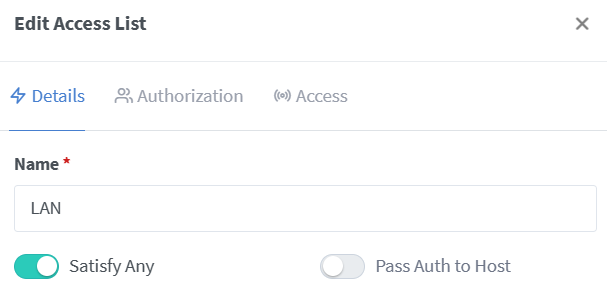
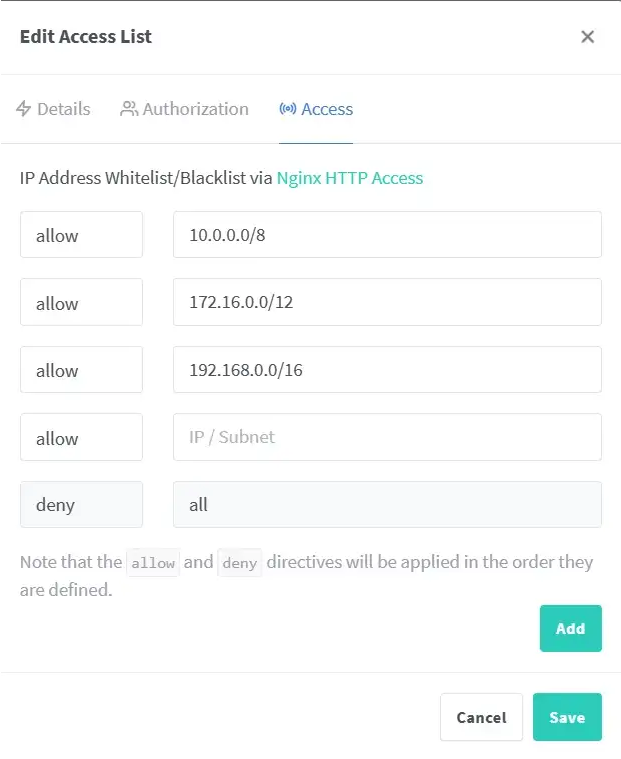
Now we move on to create “LAN or Password.” In this case it is important to indicate the “Pass authentication to host” flag to pass the credentials to the application that will serve the request, in this case HomeAssistant.
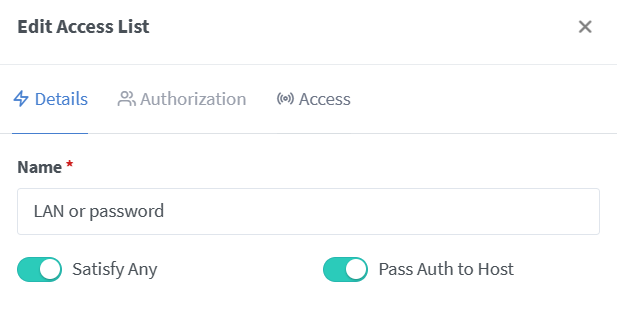
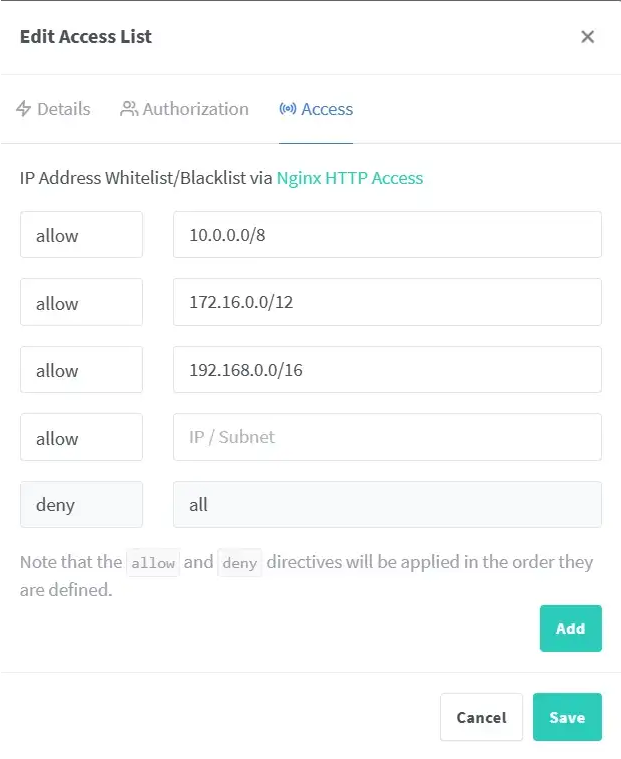
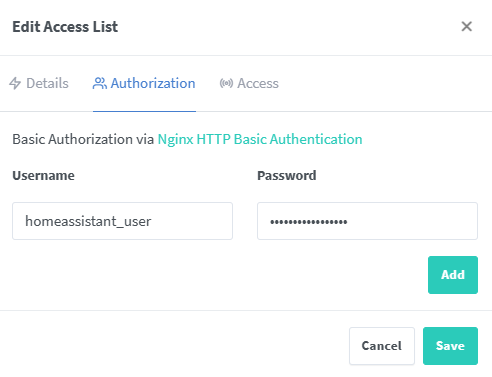
Now we can configure the hosts, the pointers to our reverse proxy. Let’s go to Hosts->Proxy Host->Add Proxy Host. Let’s go to configure HomeAssistant as our own host. In case you wanted to configure a homepage (take a look at the dashboard I propose) or other services you can do it the same way.
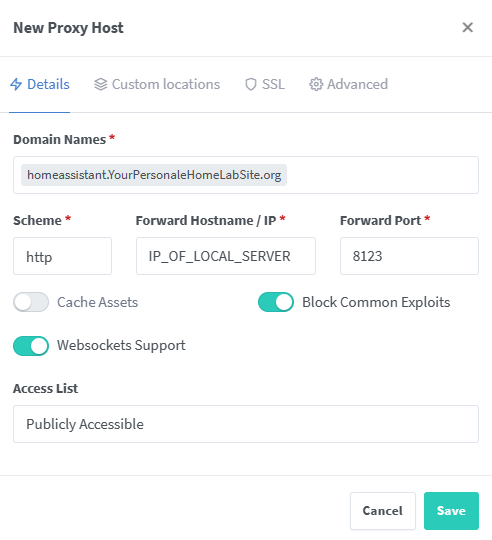

In the “location” tab add some HomeAssistant specific configuration to the “/” path:
|
|
Save, wait, and BOOM, you can now browse to https://homeassistant.YourPersonalHomeLabSite.dyndns.org to access your HomeAssistant instance, either from your network or from the outside (e.g., from your phone on a mobile network), provided you have configured port forwarding on your router as indicated in the prerequisites.
Local DNS server setup.
To use access lists based on the sender’s ip, you need to have local requests handled within your network without going through the wan. If you are requesting a page from the Internet, say from a mobile connection, a public dns will route you to the public interface of your home router, which in turn will route you to your local server. And so far so good. Conversely, if the request comes from the lan itself, perhaps a pc connected to the same network, then we have to make sure that we are not routed to our router, going out and back in our network, but we have to go directly to the local server and reverse proxy. Only in this way will our sender ip re-enter the subnet and we will be able to distinguish it from the traffic coming from outside the network. To do this we will configure a small internal dns server. To do this, create the file /opt/homelab/nginxproxymanager/dnsmasq.conf:
|
|
Once you have configured the internal dns server you will need to configure it on the router dhcp page and/or directly on the devices themselves as the primary dns server of the ip configuration.
Activating HACS plugins on HomeAssistant with Docker.
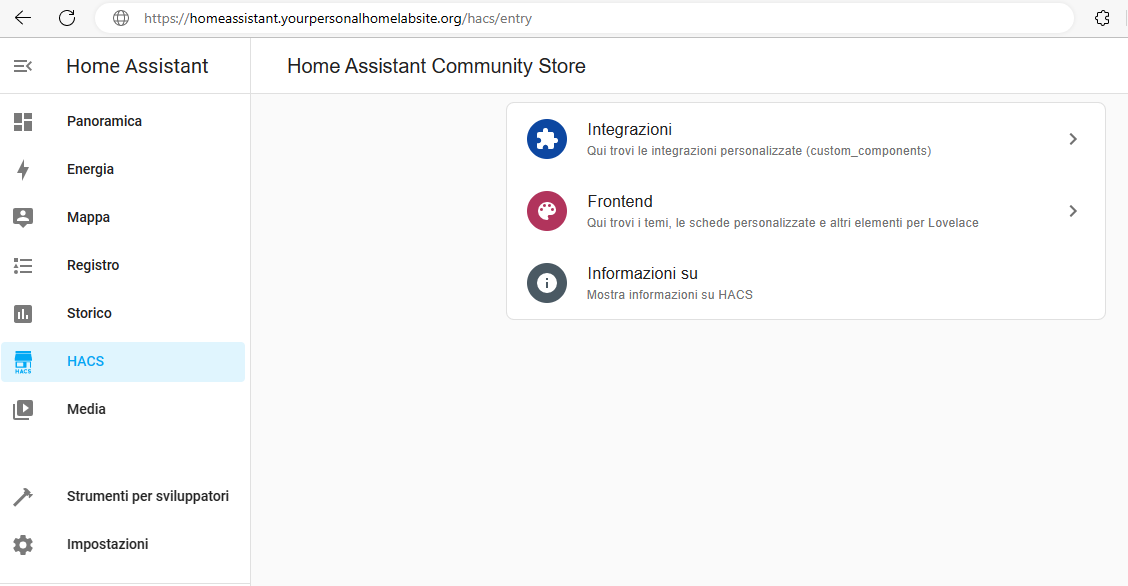
|
|
And finally a nice reboot to start from a clean condition.
Boom, you’ve done it
Now all that’s left is to configure HomeAssistant with all the devices you have inside your home.
Are your hands still itching?
- Tired of having to remember dozens of ip’s, ports, urls for each of your apps installed in your home? Take a look at the simple dashboard you can make.
- A good idea when exposing web services to the Internet is to adopt a Web Application Firewall to control and supervise traffic with the outside world.
Warnings.
You are basically exposing the reverse proxy and all hosts on the Internet, short of configured access lists, and this can pose a privacy and cybersecurity risk. For this reason you should always have an eye on testing and refining your configuration, making sure that everything is working properly and the only things accessible on the Internet are the things you want. If you browse from the outside to your public ip you will notice a 404 error screen, motivated by the fact that the reverse proxy is asked for the web page associated with that ip address. However, the reverse proxy does not know what content to provide, since no host associated with an ip address is configured.
If you want to limit the services exposed on the Internet as much as possible, all you have to do is set all hosts, except the main one in the dashboard, to the “LAN” access list.
One last thing. Google Chrome, Edge, and Google devices seem to have started using their own dns services instead of the operating system’s. This can create some problems for internal traffic, as we will notice that internal requests will go to the wan and then back again. To avoid the problem, from your browser settings just set the “use secure dns” configuration to off. Alternatively, if your home has a firewall, you can block dns requests to Google’s authoritative servers (perhaps allowing them only to your local server). I also noticed that it is best to disable the #use-dns-https-svcb-alpn flag in edge://flags/ and chrome://flags/. I discuss it here.
Need help?
If something doesn’t work as it should don’t worry, you’re on the right track. Make a pass to check point by point that the prerequisites are met and be sure to start with as clean an environment as possible. If there are still any problems, do not hesitate to leave a comment so that I or someone else can help you.